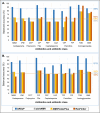Keeping up with the pathogens: improved antimicrobial resistance detection and prediction from Pseudomonas aeruginosa genomes
- PMID: 38849863
- PMCID: PMC11157771
- DOI: 10.1186/s13073-024-01346-z
Keeping up with the pathogens: improved antimicrobial resistance detection and prediction from Pseudomonas aeruginosa genomes
Abstract
Background: Antimicrobial resistance (AMR) is an intensifying threat that requires urgent mitigation to avoid a post-antibiotic era. Pseudomonas aeruginosa represents one of the greatest AMR concerns due to increasing multi- and pan-drug resistance rates. Shotgun sequencing is gaining traction for in silico AMR profiling due to its unambiguity and transferability; however, accurate and comprehensive AMR prediction from P. aeruginosa genomes remains an unsolved problem.
Methods: We first curated the most comprehensive database yet of known P. aeruginosa AMR variants. Next, we performed comparative genomics and microbial genome-wide association study analysis across a Global isolate Dataset (n = 1877) with paired antimicrobial phenotype and genomic data to identify novel AMR variants. Finally, the performance of our P. aeruginosa AMR database, implemented in our AMR detection and prediction tool, ARDaP, was compared with three previously published in silico AMR gene detection or phenotype prediction tools-abritAMR, AMRFinderPlus, ResFinder-across both the Global Dataset and an analysis-naïve Validation Dataset (n = 102).
Results: Our AMR database comprises 3639 mobile AMR genes and 728 chromosomal variants, including 75 previously unreported chromosomal AMR variants, 10 variants associated with unusual antimicrobial susceptibility, and 281 chromosomal variants that we show are unlikely to confer AMR. Our pipeline achieved a genotype-phenotype balanced accuracy (bACC) of 85% and 81% across 10 clinically relevant antibiotics when tested against the Global and Validation Datasets, respectively, vs. just 56% and 54% with abritAMR, 58% and 54% with AMRFinderPlus, and 60% and 53% with ResFinder. ARDaP's superior performance was predominantly due to the inclusion of chromosomal AMR variants, which are generally not identified with most AMR identification tools.
Conclusions: Our ARDaP software and associated AMR variant database provides an accurate tool for predicting AMR phenotypes in P. aeruginosa, far surpassing the performance of current tools. Implementation of ARDaP for routine AMR prediction from P. aeruginosa genomes and metagenomes will improve AMR identification, addressing a critical facet in combatting this treatment-refractory pathogen. However, knowledge gaps remain in our understanding of the P. aeruginosa resistome, particularly the basis of colistin AMR.
Keywords: AMR database; AMR prediction; AMR software; Antibiotic; Bioinformatics; Genomics; High-throughput sequencing; Metagenomics; Whole-genome sequencing.
© 2024. The Author(s).
Conflict of interest statement
The authors declare that they have no competing interests.
Figures


Similar articles
-
Taking the next-gen step: Comprehensive antimicrobial resistance detection from Burkholderia pseudomallei.EBioMedicine. 2021 Jan;63:103152. doi: 10.1016/j.ebiom.2020.103152. Epub 2020 Dec 4. EBioMedicine. 2021. PMID: 33285499 Free PMC article.
-
Genomic and phenotypic inconsistencies in Pseudomonas aeruginosa resistome among intensive care patients.Front Cell Infect Microbiol. 2024 Jun 21;14:1335096. doi: 10.3389/fcimb.2024.1335096. eCollection 2024. Front Cell Infect Microbiol. 2024. PMID: 38975326 Free PMC article.
-
Comparative genomics of a drug-resistant Pseudomonas aeruginosa panel and the challenges of antimicrobial resistance prediction from genomes.FEMS Microbiol Lett. 2017 Oct 2;364(18). doi: 10.1093/femsle/fnx161. FEMS Microbiol Lett. 2017. PMID: 28922838
-
Antimicrobial resistance profile of Pseudomonas aeruginosa clinical isolates from healthcare-associated infections in Ethiopia: A systematic review and meta-analysis.PLoS One. 2024 Aug 13;19(8):e0308946. doi: 10.1371/journal.pone.0308946. eCollection 2024. PLoS One. 2024. PMID: 39137234 Free PMC article.
-
Comparative genome analysis reveals putative and novel antimicrobial resistance genes common to the nosocomial infection pathogens.Microb Pathog. 2024 Dec;197:107028. doi: 10.1016/j.micpath.2024.107028. Epub 2024 Oct 18. Microb Pathog. 2024. PMID: 39426637 Review.
Cited by
-
The Colorectal Cancer Gut Environment Regulates Activity of the Microbiome and Promotes the Multidrug Resistant Phenotype of ESKAPE and Other Pathogens.mSphere. 2023 Apr 20;8(2):e0062622. doi: 10.1128/msphere.00626-22. Epub 2023 Feb 27. mSphere. 2023. PMID: 36847529 Free PMC article.
-
Discordance between different bioinformatic methods for identifying resistance genes from short-read genomic data, with a focus on Escherichia coli.Microb Genom. 2023 Dec;9(12):001151. doi: 10.1099/mgen.0.001151. Microb Genom. 2023. PMID: 38100178 Free PMC article.
References
-
- O'Neill JC. Antimicrobial resistance: tackling a crisis for the health and wealth of nations 2014. https://amr-review.org/sites/default/files/AMR%20Review%20Paper%20-%20Ta.... Accessed 1 Aug 2022.
Publication types
MeSH terms
Substances
Grants and funding
LinkOut - more resources
Full Text Sources

